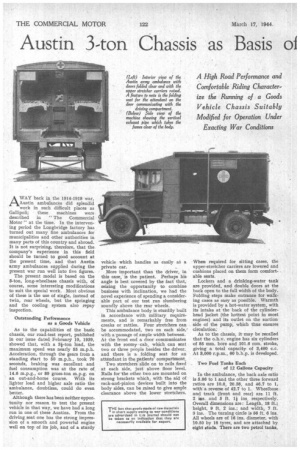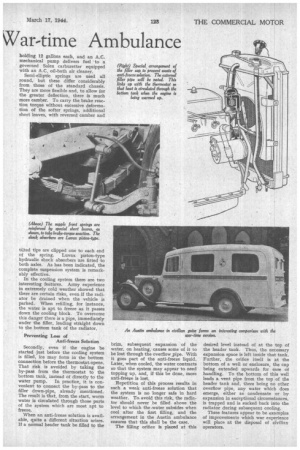Austin 3-ton Chassis as Basis oi War-time Ambulance
Page 32

Page 33

If you've noticed an error in this article please click here to report it so we can fix it.
A High Road Performance and Comfortable Riding Characterize the Running of a Goods Vehicle Chassis Suitably Modified for Operation Under Exacting War Conditions
AWAY back in the 1914-1918 war, Austin ambulances did splendid work in such difficult places as Gallipoli; these machines were described in " The Commercial Motor" at the time. In the intervening period the Longbridge factory has turned out many fine ambulances for municipalities and other authorities in many parts of this country and abroad. It is not surprising, therefore, that the company's experience in this field should be turned to good account at the present time, and that Austin army ambulances supplied during the present war run well into five figures.
The present model is based on the 3-ton, long-wheelbase chassis with, of course, some interesting modifications to suit the special work. Most obvious of these is the use of single, instead of twin, rear wheels, but the springing and the cooling system also repay inspection.
Outstanding Performance
as a Goods Vehicle As to the capabilities of the basic chassis, our road-test report, published in our issue dated February 10, 1939, showed that, with a 34-ton load, the maximum speed was nearly 55 m.p.h. Acceleration, through the gears from a standing start to 50 m.p.h., took 70 seconds, braking was excellent and fuel consumption was at the rate of 14.6 m.p.g., or 89 gross-ton m.p.g, on an out-and-home course. With its lighter load and higher axle ratio the ambulance, doubtless, could do even better.
Although there has been neither opportunity nor reason to test the present vehicle in that way, we have had a long run in one of these Austins. From the driving seat one has the strong impression of a smooth and powerful engine well on top of its job, and of a sturdy
vehicle which handles as easily ai a private car.
More important then the driver, in this case, is the patient. Perhaps his angle is best covered by the fact that seizing the opportunity to combine business with inclination, we had the novel experience of spending a considerable part of our test run slumbering soundly above the rear wheels.
This ambulance body is sturdily built in accordance with military requirements, and is remarkably free from creaks or rattles. Four stretchers can be accommodated, two on each side,with a'passage of ample width between. At the front end a door communicates with the roomy cab, which can seat two or three people besides the driver, and there is a folding seat for an attendant in the patients' compartment,
Two stretchers slide on to rails fixed at each side, just above floor level. Rails for 'the other two are mounted on strong brackets which, with the aid of rack-and-pinion devices built into the body sides, can be raised to give ample clearance above the lower stretchers. When required for sitting cases, the upper-stretcher carriers are lowered and cushions placed on them form comfortable seats.
Lockers and a drinking-water tank are provided, and double doors at the back open to the full width of the body. Folding steps make entrance for walking cases as easy as possible. Warmth is provided by a hot-water system, with its intake at the back of the cylinderhead jacket (the hottest point in most engines) and its outlet on the suction side of the pump, which thus ensures circulation:
As to the chassis, it may be recalled that the o.h.v. engine has six cylinders of 85 mm. bore and 101.6 mm. stroke, giving a total capacity, of 3,460. c.c. At 3,000 r.p.m., 60 b.h.p. is developed.
. Two Fuel Tanks Each of 12 Gallons Capacity In the ambulance, the back axle ratio is 5.86 to 1 and the other three forward ratios are 10.0, 20.38, and 46.7 to 1, with'a reverse of 42.7 to 1. Wheelbase and track (front and rear) are 11 ft. 2 ins. and 5 ft. 14 ins. respectively. Overall dimensions are: Length, 18 ft.; height, 9 ft. 2 ins.; and width, 7 ft. Sins. The turning circle is 56 ft. 6 ins. All wheels are of 16 ins, diameter, with 10.50 by 16 tyres, and are attached by eight studs. There are two petrol tanks, holding 12 gallons each, and an A.G. mechanical pump delivers fuel to a governed Solex carburetter equipped with an A.C. oil-bath air cleaner.
Semi-elliptic springs are used all round, but these differ considerably from those of the standard chassis. They are more flexible and to allow for the greater deflection, there is much more camber. To carry the brake reaction torque without excessive deformation of the softer springs, additional short leaves, with reversed camber and tilted tips are clipped one to each end of the spring. Luvax piston-type hydraulic shock absorbers are fitted to both axles. As has been indicated, the complete suspension system is remarkably effective.
In the cooling system there are two interesting features. Army experience in extremely cold weather showed that there are certain risks, even if the radiator be drained when the vehicle is parked. When refilling, for instance, the water is apt to freeze as it passes down the cooling block. To overcome this danger there is a pipe, immediately under the filler, leading straight down to the bottom tank of the radiator.
Preventing Loss of Anti-freeze Solution Secondly, even if • the engine be started just before the cooling system is filled, ice may form in the bottom connection before the thermostat opens. That risk is avoided by taking the by-pass from the thermostat to the bottom tank, instead of directly to the water pump. In practice, it is convenient to connect the by-pass to the filler down-pipe, already mentioned. The result is that, from the start, warm water is circulated through those parts of the system which are most apt to freeze,.
When an anti-freeze solution is available, qnite a different situation arises. If a normal header tank be filled to the brim, subsequent expansion of the water, on heating, causes some of it to be lost through the overflow pipe. With it goes part of the anti-freeze liquid. Later, when cooled, the water contracts so that the system may appear to need topping up, and, if this be done, more anti-freeze is lost.
Repetition of this process results in such a weak anti-freeze solution that the system is no longer safe in hard weather. To. avoid this risk, the radiator should never be filled above the level to which the .water, subsides when cool after the first filling, and the arrangement in the Austin ambulance ensures that this shall be the case.
The filling orifice is placed at this
desired level instead of at the top of the header tank. Thus, the necessary expansion space is left inside that tank. Further, the orifice itself is at the bottom of a well or enclosure, the cap being extended upwards for ease of handling. To the bottom of this well leads a vent pipe frorn the top of the header tank and, there being no other overflow pipe, any water which does emerge, either as condensate or by expansion in exceptional circumstances, is trapped and is sucked back into the radiator during subsequent cooling.
These features appear to be examples of improvements which war experience will place at the disposal of civilian operators.




























































